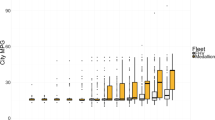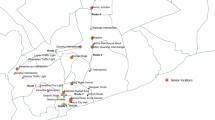Abstract
Vehicle emissions have been associated with adverse health effects in multiple epidemiological studies, but the sources or constituents responsible have not been established. Characterization of vehicle-related exposures requires detailed information on spatial and temporal trends of various pollutants and the ability to predict exposures in unmonitored settings. To address these issues, in the summer of 2001 we measured continuously particle-bound polycyclic aromatic hydrocarbons (PAHs), ultrafine particles, and PM2.5 at a number of sites in Roxbury, a neighborhood of Boston, Massachusetts with significant diesel and gasoline-fueled traffic. We took measurements at the side of the road and at varying distances from the road, with simultaneous collection of traffic counts and meteorological conditions. Across all nine sites, median roadside concentrations were 8 ng/m3 of particle-bound PAHs (range: 4–57), 16,000 ultrafine particles/cm3 (range: 11,000–53,000), and 54 μg/m3 of PM2.5 as measured with a DustTrak (range: 12–86). Concentrations of all pollutants were lower at greater distances from the road, upwind, and at higher wind speeds, with greater concentration gradients for PAHs and ultrafine particles. In linear mixed effects regression models accounting for temporal autocorrelation, large diesel vehicle counts were significantly associated with roadside concentrations of PAHs (P=0.02), with a moderate association with ultrafine particles and little relation with PM2.5. Although more comprehensive information would be needed for epidemiological applications, these data demonstrate significant spatial and temporal heterogeneity for traffic-related pollutants during the summer in an urban center, with our monitoring and analytical methodology helping to inform source attribution.
This is a preview of subscription content, access via your institution
Access options
Subscribe to this journal
Receive 6 print issues and online access
$259.00 per year
only $43.17 per issue
Buy this article
- Purchase on Springer Link
- Instant access to full article PDF
Prices may be subject to local taxes which are calculated during checkout



Similar content being viewed by others
References
Brauer M., Hoek G., van Vliet P., Meliefste K., Fischer P., Gehring U., Heinrich J., Cyrys J., Bellander T., Lewne M. and Brunekreef B. Estimating long-term average particulate air pollution concentrations: application of traffic indicators and geographic information systems. Epidemiology 2003: 14: 228–239.
Briggs D.J., Collins S., Elliott P., Fischer P., Kingham S., Lebret E., Pryl K., VanReeuwijk H., Smallbone K. and VanderVeen A. Mapping urban air pollution using GIS: a regression-based approach. Int J Geograph Inform Sci 1997: 11: 699–718.
Brunekreef B., Janssen N.A., de Hartog J., Harssema H., Knape M. and van Vliet P. Air pollution from truck traffic and lung function in children living near motorways. Epidemiology 1997: 8: 298–303.
Chang L.T., Suh H.H., Wolfson J.M., Misra K., Allen G.A., Catalano P.J. and Koutrakis P. Laboratory and field evaluation of measurement methods for one-hour exposures to O3, PM2.5, and CO. J Air Waste Manag Assoc 2001: 51: 1414–1422.
Dubowsky S.D., Wallace L.A. and Buckley T.J. The contribution of traffic to indoor concentrations of polycyclic aromatic hydrocarbons. J Expo Anal Environ Epidemiol 1999: 9: 312–321.
English P., Neutra R., Scalf R., Sullivan M., Waller L. and Zhu L. Examining associations between childhood asthma and traffic flow using a geographic information system. Environ Health Perspect 1999: 107: 761–767.
Hitchins J., Morawska L., Wolff R. and Gilbert D. Concentrations of submicrometre particles from vehicle emissions near a major road. Atmos Environ 2000: 34: 51–59.
Janssen N.A., Schwartz J., Zanobetti A. and Suh H.H. Air conditioning and source-specific particles as modifiers of the effect of PM10 on hospital admissions for heart and lung disease. Environ Health Perspect 2002: 110: 43–49.
Kim S., Shen S. and Sioutas C. Size distribution and diurnal and seasonal trends of ultrafine particles in source and receptor sites of the Los Angeles basin. J Air Waste Manag Assoc 2002: 52: 297–307.
Kinney P.L., Aggarwal M., Northridge M.E., Janssen N.A. and Shepard P. Airborne concentrations of PM2.5 and diesel exhaust particles on Harlem sidewalks: a community-based pilot study. Environ Health Perspect 2000: 108: 213–218.
Laden F., Neas L.M., Dockery D.W. and Schwartz J. Association of fine particulate matter from different sources with daily mortality in six U.S. cities. Environ Health Perspect 2000: 108: 941–947.
Levy J.I., Dumyahn T. and Spengler J.D. Particulate matter and polycyclic aromatic hydrocarbon concentrations in indoor and outdoor microenvironments in Boston, Massachusetts. J Expo Anal Environ Epidemiol 2002: 12: 104–114.
Levy J.I., Houseman E.A., Spengler J.D., Loh P. and Ryan L. Fine particulate matter and polycyclic aromatic hydrocarbon concentration patterns in Roxbury, Massachusetts: a community-based GIS analysis. Environ Health Perspect 2001: 109: 341–347.
Massachusetts Highway Department. Traffic Volume Counts. Available at: http://www.state.ma.us/mhd/trafficc/traffic.htm, May 2001.
Nielsen T. Traffic contribution of polycyclic aromatic hydrocarbons in the center of a large city. Atmos Environ 1996: 30: 3481–3490.
Oosterlee A., Drijver M., Lebret E. and Brunekreef B. Chronic respiratory symptoms in children and adults living along streets with high traffic density. Occup Environ Med 1996: 53: 241–247.
Quintana P.J., Samimi B.S., Kleinman M.T., Liu L.J., Soto K., Warner G.Y., Bufalino C., Valencia J., Francis D., Hovell M.H. and Delfino R.J. Evaluation of a real-time passive personal particle monitor in fixed site residential indoor and ambient measurements. J Expo Anal Environ Epidemiol 2000: 10: 437–445.
Rea A.W., Zufall M.J., Williams R.W., Sheldon L. and Howard-Reed C. The influence of human activity patterns on personal PM exposure: a comparative analysis of filter-based and continuous particle measurements. J Air Waste Manage Assoc 2001: 51: 1271–1279.
Ruuskanen J., Tuch T., Ten Brink H., Peters A., Khlystov A., Mirme A., Kos G.P.A., Brunekreef B., Wichmann H.E., Buzorius G., Vallius M., Kreyling W.G. and Pekkanen J. Concentrations of ultrafine, fine, and PM2.5 particles in three European cities. Atmos Environ 2001: 35: 3729–3738.
Tolbert P.E., Klein M., Metzger K.B., Peel J., Flanders W.D., Todd K., Mulholland J.A., Ryan P.B. and Frumkin H. Interim results of the study of particulates and health in Atlanta (SOPHIA). J Expo Anal Environ Epidemiol 2000: 10: 446–460.
US Department of Transportation, Federal Highway Administration. Traffic Monitoring Guide. Available at: http://www.fhwa.dot.gov/ohim/tmguide/, August 16 2002.
US Environmental Protection Agency. Compilation of Air Pollutant Emission Factors, Volume II: Mobile Source, 4th edn. US Government Printing Office, Washington, DC, 1985.
US Environmental Protection Agency. NEDS Source Classification Codes and Emission Factor File. US EPA Office of Air Quality Planning and Standards, Research Triangle Park, NC, 1989.
van Vliet P., Knape M., de Hartog J., Janssen N., Harssema H. and Brunekreef B. Motor vehicle exhaust and chronic respiratory symptoms in children living near freeways. Environ Res 1997: 74: 122–132.
Venn A.J., Lewis S.A., Cooper M., Hubbard R. and Britton J. Living near a main road and the risk of wheezing illness in children. Am J Respir Crit Care Med 2001: 164: 2177–2180.
Weiland S.K., Mundt K.A., Ruckmann A. and Keil U. Self-reported wheezing and allergic rhinitis in children and traffic density on street of residence. Ann Epidemiol 1994: 4: 243–247.
Wjst M., Reitmeir P., Dold S., Wulff A., Nicolai T., von Loeffelholz-Colberg E.F. and von Mutius E. Road traffic and adverse effects on respiratory health in children. Br Med J 1993: 307: 596–600.
Yu O., Sheppard L., Lumley T., Koenig J.Q. and Shapiro G.G. Effects of ambient air pollution on symptoms of asthma in Seattle-area children enrolled in the CAMP study. Environ Health Perspect 2000: 108: 1209–1214.
Zhu Y., Hinds W.C., Kim S., Shen S. and Sioutas C. Study of ultrafine particles near a major highway with heavy-duty diesel traffic. Atmos Environ 2002a: 36: 4323–4335.
Zhu Y., Hinds W.C., Kim S. and Sioutas C. Concentration and size distribution of ultrafine particles near a major highway. J Air Waste Manage Assoc 2002b: 52: 1032–1042.
Acknowledgements
Funding for this investigation was provided by the US EPA (Grant #R825267) and by the Kresge Center for Environmental Health (NIEHS ES000002). We thank Maneesh Anand, Kevin Banahan, Prashant Dilwali, Thy Do, Thomas Dumyahn, Kevin Han, and Nicholas Lange for their assistance with field measurements.
Author information
Authors and Affiliations
Corresponding author
Rights and permissions
About this article
Cite this article
Levy, J., Bennett, D., Melly, S. et al. Influence of traffic patterns on particulate matter and polycyclic aromatic hydrocarbon concentrations in Roxbury, Massachusetts. J Expo Sci Environ Epidemiol 13, 364–371 (2003). https://doi.org/10.1038/sj.jea.7500289
Received:
Accepted:
Published:
Issue Date:
DOI: https://doi.org/10.1038/sj.jea.7500289
Keywords
This article is cited by
-
Addressing systemic problems with exposure assessments to protect the public’s health
Environmental Health (2023)
-
Spatial and seasonal variation of outdoor BC and PM2.5 in densely populated urban slums
Environmental Science and Pollution Research (2021)
-
Exposure to air pollutants among cyclists: a comparison of different cycling routes in Perth, Western Australia
Air Quality, Atmosphere & Health (2020)
-
Foliar Particulate Matter Distribution in Urban Road System of Beijing, China
Chinese Geographical Science (2019)
-
Children exposure to indoor ultrafine particles in urban and rural school environments
Environmental Science and Pollution Research (2016)



